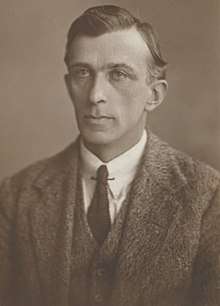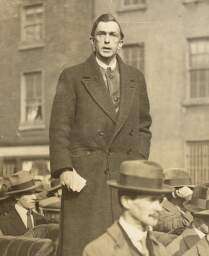Rory O'Connor (Irish republican)
Rory O'Connor (Irish: Ruairí Ó Conchubhair; 28 November 1883 – 8 December 1922) was an Irish republican revolutionary. He is best remembered for his role in the Irish Civil War (1922–23), and the circumstances of his execution.
Rory O'Connor | |
|---|---|
 Portrait of O'Connor, December 1922 | |
| Born | 28 November 1883 Dublin, Ireland |
| Died | 8 December 1922 (aged 39) Mountjoy Gaol, Dublin, Ireland |
| Allegiance | Irish Republic Irish Republican Brotherhood Irish Volunteers |
| Service/ | Anti-Treaty IRA |
| Battles/wars | Easter Rising Irish War of Independence Irish Civil War |
Background
O'Connor was born in Dublin November 28, 1883, and executed as a reprisal on December 8, 1922. He was born in Kildare Street, Dublin, and educated in St Mary's College, Dublin and then in Clongowes Wood College, a public school run by the Jesuit order and also attended by James Joyce, and by the man who would later condemn Rory O'Connor to death, his close friend Kevin O'Higgins.
In 1910 O'Connor took his Bachelor of Engineering and Bachelor of Arts degrees in University College Dublin, then known as the National University. He went to work as a railway engineer in Ireland, then moved to Canada, where he was an engineer in the Canadian Pacific Railway and Canadian Northern Railway, being responsible for the construction of 1,500 miles (2,400 km) of railroad.[1] He returned to Ireland in 1915 at Joseph Plunkett's request and worked for Dublin Corporation as a civil engineer. He joined the ultra-Catholic nationalist organisation the Ancient Order of Hibernians, and served in the Easter Rising in 1916 in the GPO as an intelligence officer. He was wounded by a sniper during reconnaissance at the College of Surgeons.[2]
The War of Independence

During the subsequent Irish War of Independence from 1919 to 1921 he was Director of Engineering of the Irish Republican Army (IRA), a military organisation descended from the Irish Volunteers. The specialist skills of engineering and signalling were essential to the development of the 5th Battalion, Dublin Brigade. Its men were forbidden frontline duty as their contribution was regarded as vital, their number too small. But units only expanded on an incremental local basis, disappointing Gen Richard Mulcahy.[3]
O'Connor was also involved in the Republican breakout from Strangeways Prison in Manchester, England on 25 October 1919. Michael Collins had taken a particular interest in the escape, and actually visited Austin Stack in the prison in under a false name to finalise the arrangements. IRA men held up traffic while a ladder was propped up against the outside of a prison wall. In all six prisoners were to escape, among them Piaras Beaslaí who had again been arrested.[4]
Events leading to the Civil War
O'Connor refused to accept the Anglo-Irish Treaty of 1921, which established the Irish Free State and which was ratified by a narrow vote by Dáil Éireann, but which instituted the partition of the six counties of Northern Ireland and abolished the Irish Republic declared in 1916 and 1919, which O'Connor and his comrades had sworn to uphold. Oh we must work it for all its worth. If I could get enough to support me I would oppose it wholeheartedly, O'Connor said to a fellow-IRA man, Liam Archer.[5]
On 26 March 1922, the anti-treaty officers of the IRA held a convention in Dublin, in which they rejected the Treaty compromise and repudiated the authority of the Dáil, the elected Irish Parliament, but were prepared to discuss it. The Convention met again on 9 April, and a new army constitution was ratified and created a new GHQ.[6] Asked by a journalist if this meant they were proposing a 'military dictatorship' in Ireland, O'Connor replied, "You can take it that way if you want."[7]
On 14 April 1922 O'Connor, with 200 other anti-treaty IRA men under his command, took over the Four Courts building in the centre of Dublin in defiance of the Provisional Government. They intended to provoke the British troops (who were still in the country) into attacking them, which they thought would restart the war with Britain, and re-unite the IRA against their common enemy. They also occupied other smaller buildings regarded as being associated with the former British administration, such as the Ballast Office and the Freemasons' Hall in Molesworth Street, but the Four Courts remained the focus of interest. On 15 June, O'Connor sent out men to collect the rifles that belonged to the mutineers of the Civic Guards.
Michael Collins tried desperately to persuade O'Connor and his men to leave the building during the next three months. At the Third IRA Convention, the executive was split over whether the Irish Government should demand that all British troops leave within 72 hours. The motion was defeated, but the IRA split into two factions opposed to the government, one conciliatory, led by Liam Lynch, Sean Moylan, and Liam Deasy, and the other less moderate, led by Tom Barry and Joe McKelvey.
On 22 June 1922 Sir Henry Wilson was assassinated in London by two IRA men, both former British soldiers, Reginald Dunne and Joseph O'Sullivan. It is now considered by some that this was done on the orders of Michael Collins, who had been a close friend of Dunne in the London IRB.[8] Lloyd George wrote an angry letter to Collins which included the line ...still less can Mr. Rory O'Connor be permitted to remain his followers and his arsenal in open rebellion in the heart of Dublin... organizing and sending out from this centre enterprises of murder not only in the area of your Government...
On 28 June 1922, after the Four Courts garrison had kidnapped Ginger O'Connell, a general in the new Free State Army, Collins began shelling the Four Courts with borrowed British artillery. British soldiers still in Ireland and expert in the use of their cannons helped bomb the Four Courts. O'Connor and 130 men surrendered on 30th June and was arrested and imprisoned in Mountjoy. This incident sparked the Irish Civil War as fighting broke out around the country between pro and anti-treaty factions.[9]
Execution
On 8 December 1922, along with three other republicans Liam Mellows, Richard Barrett and Joe McKelvey captured with the fall of the Four Courts, Rory O'Connor was executed by firing squad in reprisal for the anti-treaty IRA's killing of Free State TD Sean Hales. The execution order was signed by Kevin O'Higgins. O'Connor had been best man at his wedding on 27 October 1921. The killing remains as a symbol of the bitterness and division of the IRA's Civil War. O'Connor, one of 77 republicans executed by the Cumann na nGaedheal government of the Irish Free State, is seen as a martyr by the Republican movement in Ireland.
Commemoration
"Rory O'Connor Place" in Arklow is named in his honour. There is also a pub in Crumlin, Dublin named after him, and a residential road in Dean's Grange, Dún Laoghaire (County Dublin), called "Rory O'Connor Park".
On his execution, the equestrienne Joan de Sales La Terriere, a close friend of O'Connor, named her son in his honour.
Sources
- Costigan, G, 'The Anglo-Irish Conflict 1919-1922: The War of Independence or systematized murder?', University Review (1968), vol.5 (1), p. 64–86.
- Cottrell, P, The Irish Civil War 1922-1923 (Botley, Oxford 2008)
- Foster, G, 'Republicans and the Irish Civil War', New Hibernian Review (2012) p. 20–42.
- Hart, P, IRA at War 1916-1923 (OUP 2005)
- Hopkinson, Michael, Green against Green: the Irish Civil War (Dublin 1988)
- Hopkinson, M, The Irish War of Independence (Dublin and Montreal 2002)
- Macardle, Dorothy, The Irish Republic 1911-1923 (London 1937)
- O'Malley, Ernie, The Singing Flame (Dublin 1963)
- Purdon, Edward, The Irish Civil War 1922-23 (The Mercier Press Ltd 2000) ISBN 1856353001
Notes
- http://bureauofmilitaryhistory.ie/reels/bmh/BMH.WS0527.pdf#page=2
- http://bureauofmilitaryhistory.ie/reels/bmh/BMH.WS0907.pdf#page=51
- Townshend, C, "The Republic", p.188.
- Michael Collins by Tim Pat Coogan, page 99
- University College of Dublin Archives P53/344.
- Townshend, C , "The Republic" p.392.
- Article quoting this phrase; accessed Dec 2009 Archived 2006-05-31 at the Wayback Machine
- http://treaty.nationalarchives.ie/wp-content/uploads/2011/11/Collins.pdf
- Macardle, "Irish Republic" pp.679-81.
- Sinn Féin UCD [@SF_UCD] (8 December 2016). "96 yrs ago today Rory O'Connor was executed for rebelling against the treaty! O'Connor, a UCD grad, is proudly reme…" (Tweet) – via Twitter.